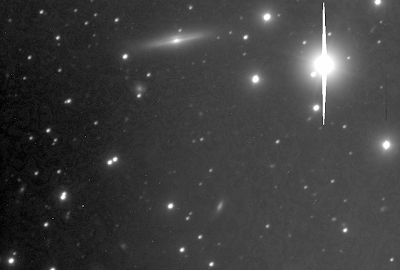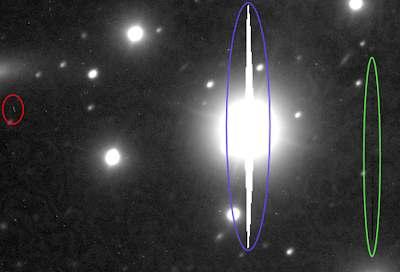- Why does the Earth experience seasons?
This seems like a reasonable explanation, but breaks down when you consider that the Northern Hemisphere and Southern Hemisphere experience opposite seasons. When it's summer in the USA and Europe, it's winter in Australia, and vice versa. It runs into more trouble when you consider the Earth is actually closest to the Sun in January, and farthest in July...exactly the opposite of what you'd expect for the Northern Hemisphere if this explanation were true.
The real answer here involves the Earth's "axial tilt". The axis about which the Earth rotates is at a constant tilt of 23.5 degrees. This means at certain times of the year, the Northern Hemisphere is more directly facing the Sun, while 6 months later when the Earth is on the other side of the Sun, the Southern Hemisphere is more directly facing the Sun. Note the diagram:

I've marked the equator and the axis of rotation in red. The hemisphere which more directly faces the Sun is the one which experiences summer. The hemisphere angled away from the Sun is the one experiencing winter.
Another common "almost right, but not quite" answer I've heard several times involves the tilt, but in the wrong way. Those folks maintain that because the Earth is tilted, one hemisphere is closer to the Sun than the other. However, this effect is minuscule, since the tilt only accounts for a difference in distance to the Sun of a couple thousand kilometers, while the average distance to the Sun is 150 million kilometers. Again, seasons have nothing to do with distance, it's all about angles.
- Why is there a 24 hour day-night cycle?
(Now, technically, the Earth makes a full 360 degree rotation in only 23 hours, 56 minutes...but because the Earth has also traveled about 1 degree in its orbit around the Sun during that time, the Earth must rotate an extra 1 degree to bring the Sun back to the same relative position. Thus, the 4 extra minutes.)
Most folks get this one, but there are still some who maintain that the Earth doesn't rotate at all, and just orbits once around the Sun per day. Woe is them.
- Why is the sky blue?
I've gotten simply wrong responses such as "the sky is simply reflecting the ocean". In the middle of a continent far from any ocean, though, the sky is still blue. I've also gotten the "almost correct" response that the atmosphere is refracting the sunlight. It does involve the atmosphere interacting with sunlight, which is good...but still not quite right.
The correct answer here has to do with scattering, specifically - "Rayleigh scattering". When light has a wavelength close to the size of a gas molecule it's passing near, there's a good chance the light will essentially "bounce" off the molecule and start heading in a different direction.
Moreover, the chance of scattering is also very dependent on wavelength - it scales as 1 over the wavelength to the fourth power. In other words, short wavelengths are much more likely to scatter than long wavelengths. Our eyes interpret the different wavelengths of light as different colors. Red light's wavelength is roughly twice as long as blue light, so blue light is 2 to the 4th power = 16 times more likely to scatter than red light.
So, imagine incoming sunlight coming from the Sun and passing through our atmosphere. Remember, the sun emits every colors of the rainbow, it's just that when the colors are all combined, they appear to us as white light. Now, the red light is more likely to make it through unhindered, while the blue light gets scattered everywhere and appears to an observer on the ground to be originating from a direction other than the Sun. Hopefully this diagram will help explain the concept:

As you can see, most colors on the red side of the spectrum appear to be coming from the direction of the Sun. The blue light (and a bit of the green), however, appear to be coming from elsewhere in the sky. This process happens all over the sky, so it appears that blue light is coming from everywhere.
This also explains why our sun appears slightly more yellow than it would from space. Some of the blue gets scattered out of our line of sight towards the Sun.
- Why are sunsets red?
- How does the Earth compare to other planets?
Within our own Solar System, planets can be divided into two groups - the inner, terrestrial rocky planets (Mercury, Venus, Earth, and Mars) and the outer gas giant planets (Jupiter, Saturn, Uranus, and Neptune). Earth is the largest of the inner rocky planets, but many times smaller than the outer gas giants. So, it could be said to fit somewhere in the middle, albeit slightly on the smaller side.
On the other hand, if you take the ~300 planets known around other stars, Earth is quite dwarfed. Just about all of these "extrasolar" planets are massive gas giants - many larger than Jupiter - and most of which are found orbiting incredibly close to their parent star. Within that population, Earth is no more than a puny wet rock.
Of course it's quite likely that this known collection of extrasolar planets are not representative of the population of planets as whole. The problem is that our observing techniques for detecting these distant worlds are severely biased towards only detecting very large planets which orbit very close to their parent star. The hope is that with improving technology, we'll start detecting Earth-like planets in a matter of a few years, particularly with space-based missions such as Kepler.
- Why does a feather fall slower than a bowling ball?
It turns out that the only thing which slows down the feather is increased air resistance. In essence, it has a much lower terminal velocity than the bowling ball. (Terminal velocity is the fastest a given object of a given shape can fall - it's the speed at which the Earth's gravitational acceleration is perfectly balanced by the force exerted by air friction.)
Take away the air, and everything - no matter its weight - falls at the same rate. Check out this video from one of the Apollo moon landings - you'll see that in the absence of any air, a hammer and a feather fall at exactly the same rate.
Now, technically the bowling ball, with a larger mass, feels a stronger gravitational force. However, because it has a larger mass, it's inertia is also greater...in other words, you need more force to get it going. It turns out that its increased gravitational force perfectly balances its increased inertia, resulting in all things falling at the same rate (in a vacuum).




